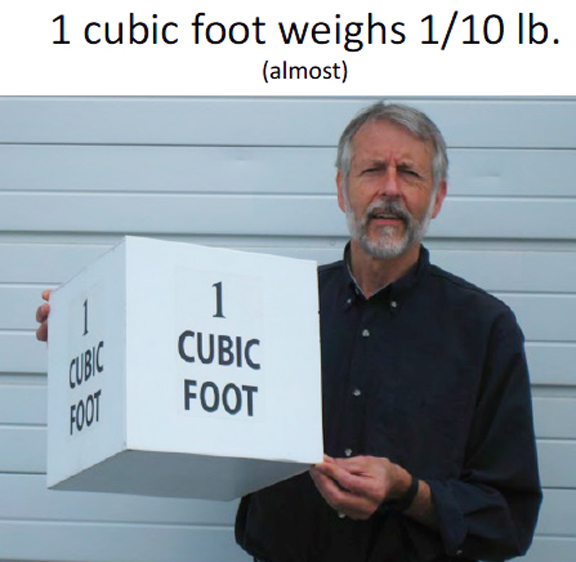
Image Credit: All imags: David Hill
Image Credit: All imags: David Hill Air flow at a rectangular fitting is subject to more or less turbulence based on the shape of the turn. In this figure, the elbow has a square throat and a square heel, the worst configuration for turbulence and air flow. David Hill presented the results of his oval duct study at the 2015 Building Science Summer Camp. Round and oval duct come from the same stock. An oval duct is simply a round duct that's been squashed. The oval fittings study resulted in a chart and table of 16 branch duct systems incorporating oval ducts and fittings that are in common use.
At my first Building Science Summer Camp in 2011, David Hill gave a great presentation on some of the big problems with duct systems. (In case you weren’t reading this blog back then, I got myself invited with my 2010 article called I Don’t Need No Stinkin’ Building Science Summer Camp.)
Michael Chandler ably summarized that talk in his article, Stuff I Learned at Joe Lstiburek’s House, Part 2. This year, Hill did a followup presentation, reprising some of his main points but also adding two new pieces, one of which is a nice study he’s done on air flow in oval ducts.
Furnaces are getting smaller
In the first half of Hill’s presentation, he reminded us about some of the fundamentals of air flow in ducts that he covered in 2011. But he did throw out one new thing there: He said that manufacturers, in their drive to improve efficiency of their equipment, are making furnace cabinets smaller while at the same time increasing air flow. Then there’s the absence of integrated design in new construction, leaving HVAC designers and installers not nearly enough room to do their jobs well, so duct systems are smaller, too. The combined effects, Hill said, make furnaces like “a pinhole with a hurricane going through it.”
Air flow, friction rates, and equivalent length
As mentioned above, Michael Chandler did a good job summarizing Hill’s 2011 presentation, so I won’t do much more with his reprise of that here. I do want to say a few things, though, because air flow is so important and so often misunderstood.
One thing certainly bears repeating from Hill’s presentations, though, is that air flow can be reduced two ways. The first is friction, or air resistance. The second is turbulence. Friction happens throughout. Turbulence happens mainly when you turn the air in the duct system.
HVAC designers often use something called a ductulator to determine the sizing of the ducts they use, but it’s easy to misuse a ductolator. Ductulators tell you how much pressure drop you’ll get in a 100-foot run of straight duct of a certain type. They don’t tell you what happens when you get turbulence at the fittings.
That’s where this thing called equivalent length comes in. Each type of fitting is assigned an equivalent length, which is the length of straight duct of the same type and size that would give you an equivalent amount of friction (or pressure drop). So what you do is figure out the total equivalent length of your most restrictive run in a duct system and design for that pressure drop.
When is an oval not round?
Oval ducts are used sometimes because they fit inside wall cavities. Because they have the rounded corners instead of square, a lot of installers assume that oval ducts are equivalent to round ducts. If you look at the photo below (see Image #4), you’ll notice that the oval duct is really just a round duct that’s been flattened out. It’s even stamped with the same number — 6” — even though the dimensions are different.
It turns out that the air flow properties are different, too, although they haven’t been studied much. Hill and his colleagues undertook a research project to find the equivalent lengths of some common oval fittings, and he showed the numbers in his presentation.
If you download Hill’s presentation and scroll down to page 15, you can see what they found. One thing they found is that the straight duct itself moves less air than the same size round duct. They compared a 6” round duct to two forms of oval duct made from a 6” round: 3” x 7.71” and 3.25” x 7.57”. Their measurements showed that those two sizes of oval duct are equivalent to round duct at 5.02” and 5.18”, respectively.
In the end, they put together a nice chart and table of the equivalent lengths of various oval fittings. As you can see in the table below (see Image #5), one of them is a real pig, coming in with an equivalent length of 149’. That’s the transition piece from 5” round to 5” oval. If you want 6” oval, you really should go with 5” round because that has an equivalent length of only 24’. If you need the 6” round on one end, take the oval up to 8” and your equivalent length is 60’. In short, the oval side needs to be bigger than the round side.
This was great work by Hill and the group he worked with on the oval duct study. Air flow is a huge problem with a huge number of forced air systems, so the more we can hear about how to do it right, the better.
Allison Bailes of Decatur, Georgia, is a speaker, writer, energy consultant, RESNET-certified trainer, and the author of the Energy Vanguard Blog. Check out his in-depth course, Mastering Building Science at Heatspring Learning Institute, and follow him on Twitter at @EnergyVanguard.
Weekly Newsletter
Get building science and energy efficiency advice, plus special offers, in your inbox.












0 Comments
Log in or create an account to post a comment.
Sign up Log in